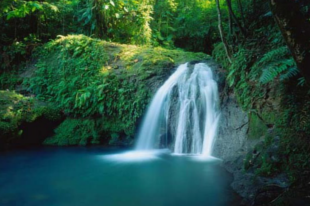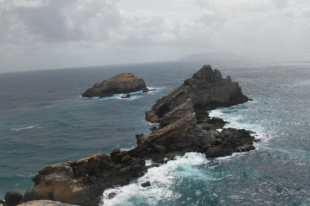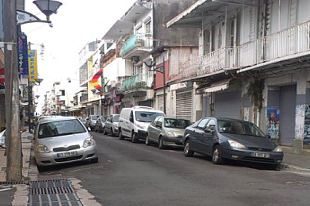Guadeloupe
is an insular region of France located in the Leeward Islands, part of the Lesser Antilles in the Caribbean. Administratively, it is an overseas region consisting of a single overseas department. Guadeloupe's two main islands are Basse-Terre to the west and Grande-Terre to the east, which are separated by a narrow strait that is crossed with bridges. They are often referred to as a single island. The department also includes the Dependencies of Guadeloupe which include the smaller islands of Marie-Galante and La Désirade, and the Îles des Saintes. Guadeloupe, like the other overseas departments, is an integral part of France.
Resembling a butterfly, its 2 largest islands are separated by the Salée River. Hilly Grande-Terre has long beaches and sugarcane fields. On Basse-Terre, Parc National de la Guadeloupe encompasses hiking trails, 3-tiered Carbet Falls and active volcano La Grand Soufrière. Smaller islands include Marie-Galante and La Désirade.
Population: 403,750(2014)
Area: 629 mi²
Capital: Basse-Terre
Languages: French
Currency
The local currency in Guadeloupe is the Euro. Although U.S. dollars and traveler's checks (which are increasingly rare) may be accepted at some locations, it's best to rely primarily on major credit cards for larger purchases, and cash for small purchases. Be sure to check with your credit card company to see if you'll be charged foreign currency conversion fees. Visa and MasterCard are generally accepted, but most merchants do not accept American Express or Discover cards.
Climate
In Guadeloupe, the climate is tropical, hot and humid all year round, with little variation in temperature between the coolest months, which are January and February, with about 24 °C as daily average, and the warmest months, from June to October, with an average of 27 °C. The most sweltering months are September and October.
Health and Safety
Bring lots of sunscreen!
There are Metropole-style pharmacies which carry top of the line French sunscreen, that can be expensive.
Also, keep hydrated, especially when hiking in the mountainous areas. A hat is often a good thing to have because the sun can get extremely hot.
There is no particular disease but you should protect yourself from the sun. Sanitary and medical facilities in Guadeloupe are good. Health care in Guadeloupe is controlled by a state-owned organisation (Sécurité Sociale). Doctors are available in almost every village. Tap water is usually safe for consumption. Public sources of water are unsafe if labeled with "Eau non potable" (no drinking water). Visitors from European Union should bring a European Health Insurance Card or EHIC (formerly the E111 form) with them. Ask details at your local health care organisation.
Emergency Numbers
Emergency services: 112;
Fire brigade: 18;
Police station: 17;
Specialised emergency medical service (called SAMU): 15.
Getting Around
The bus system is infrequent and unreliable. Cars can be hired at the airport in Pointe-à-Pitre: Rentacar Guadeloupe [8] The main roads are of the same quality as metropolitan France, but smaller roads are often uneven, pot-holed and frankly dangerous. Prudence is required! Drivers are often undisciplined, but rarely aggressive.
Activitie
See the waterfalls
Guadeloupe is an island with plenty of waterfalls. The most famous ones are Les Chutes du Carbet, but there is a long hike until you reach them. If you do not feel like walking, you can visit several smaller waterfalls, located just few hundred meters away from the main road.
Shop at Pointe-A-Pitre
Pointe-A-Pitre is the capital city of Guadeloupe, and, at the same time, the biggest city on the island. It is located between two butterfly wings, Grande-Terre and Basse-Terre. If you are going to Pointe-A-Pitre to see some good beaches, you better look somewhere else. There is no public beach there, and there is a port, hence the water is dirty and not good for swimming.
Hike to the top of Pointe des Chateaux
Pointe des Chateaux is a viewpoint, located at the south – east part of the island, not accessible by public transport. From the top, you can see other islands of the archipelago, if the weather is clear. From the bottom to the top, it will take about 25 minutes of slow walking. Bring enough to drink with you, and a sunscreen, because there is no shade on the way up. When you reach the top, you will be rewarded with a great view.
Go snorkeling at La Malendure
La Malendure beach is the beach with black sand and it is known as the most famous diving and snorkeling spot on the island. They organise snorkeling excursions to the nearby Pigeon island and Jacques Coasteau underwater marine reserve. You can also go snorkeling from the shore, and you do not have to be lucky to see turtles in the water, because there are plenty of them. You wil also spot many tropical fish. The only bad thing about this beach is, that the deeper the water gets, the poorer the visibility is, because of the black sand.
 |
 |
 |












